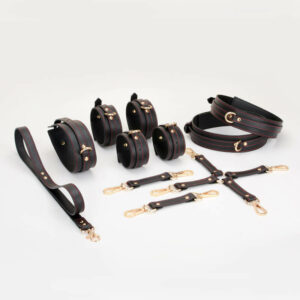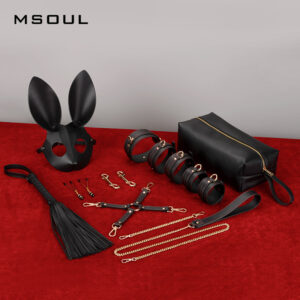In the intricate dance of BDSM, submissives play a crucial role, bringing depth, trust, and vulnerability to the dynamic. Their willingness to surrender control to a dominant partner forms the foundation of BDSM, creating a space where desires and boundaries are explored. Submissives derive pleasure from serving, obeying, and experiencing the intensity of their partner’s dominance. While each submissive is unique, they commonly share a profound desire for submission, often finding empowerment and fulfillment in surrendering to their dominant counterpart. Let’s delve into the intriguing world of types of submissives and discover the unique qualities that define them.
Contents
ToggleBrat
The Brat submissive stands out as a playful and spirited archetype. Brats derive pleasure from challenging their dominant partner, often teasing and provoking to evoke a response. This archetype thrives on the dynamic interplay of resistance and discipline, finding enjoyment in the push-and-pull. Common traits of a Brat include a strong-willed nature, a penchant for defiance, and a desire to be tamed through assertive dominance. The challenge for dominants lies in navigating this spirited resistance, fostering a balance that keeps the dynamic exciting and mutually satisfying.
Common Traits of a Brat
Playful Defiance: Brats often engage in lighthearted defiance, pushing boundaries with a mischievous and playful spirit.
Need for Discipline: They seek the thrill of being disciplined and enjoy the structure that comes with a dominant asserting control.
Communication Style: Brats may express their submission through banter and sarcasm, creating a dynamic where verbal sparring is part of the play.
Desire for Attention: Attention is a key motivator for Brats, and they may provoke reactions from their dominant to feel desired and wanted.
Test of Dominance: The Brat’s actions serve as a test of the dominant’s ability to assert control, creating a dynamic of constant negotiation and power play.

Service Sub
The Service Submissive is a unique archetype, finding fulfillment through acts of service, devotion, and anticipation of their dominant’s needs. This submissive type experiences joy and purpose in catering to their dominant’s desires, often embodying qualities of selflessness and attentiveness. Their satisfaction is derived from fulfilling tasks, providing comfort, and creating an environment of care.
Common Traits of a Service Sub
Devotion: Service subs display a high level of devotion to their dominant, finding fulfillment in meeting their partner’s needs.
Attentiveness: They are highly attuned to the desires and preferences of their dominant, anticipating needs before they are expressed.
Joy in Acts of Service: Performing tasks, chores, or acts that contribute to the well-being and pleasure of their dominant brings a deep sense of satisfaction.
Selflessness: Service subs prioritize the happiness and comfort of their dominant, often placing their partner’s needs above their own.
Structured Roles: These submissives may thrive in clearly defined roles where they have specific tasks and responsibilities, contributing to a sense of order and purpose.
Sexual Sub
The Sexual Submissive is a distinct archetype in BDSM, finding their primary source of pleasure and fulfillment in the realm of sexual activities and exploration.
Common Traits of a Sexual Submissive
Passion for Erotic Exploration: Sexual subs are enthusiastic about exploring a wide range of sexual activities, fetishes, and fantasies with their dominant.
Sensory Stimulation: They may be particularly responsive to sensory experiences, enjoying elements like sensory deprivation, role-playing, or the use of erotic accessories.
Adventurous Nature: Sexual subs often have an adventurous spirit, seeking novelty and variety in their intimate encounters.
Verbal and Physical Submission: Communication and physical expression are key for sexual subs, who may derive pleasure from verbal submission, explicit instructions, or physical restraint.
Masochist
The Masochist is a submissive archetype characterized by their inclination towards receiving physical or psychological pain for pleasure. This type of submissive finds gratification and arousal through the experience of discomfort.
Common Traits of a Masochist
Pleasure in Pain: Masochists derive pleasure from various forms of pain, which can include spanking, whipping, bondage, or other physically intense activities.
Endurance and Thresholds: They often have a high pain threshold and may actively seek to expand their limits over time, enjoying the challenge of pushing boundaries.
Bottom
The Bottom is a submissive role in BDSM that focuses on receiving, whether it be sensations, actions, or commands, without necessarily surrendering control or authority. Unlike the more comprehensive submissive roles, the Bottom may engage in specific activities while maintaining a sense of autonomy and negotiation within the scene.
Common Traits of a Bottom
Selective Submission: Bottoms often choose to submit in specific contexts or activities, maintaining a degree of control over the scope and intensity of their submission.
Focus on Sensation: The primary focus for Bottoms is often the physical or sensory experience. This could include enjoying certain acts, such as impact play or bondage.

Bedroom Submissive
The Bedroom Submissive is a role in BDSM that primarily comes to life within the confines of intimate relationships and sexual encounters. Unlike broader submissive roles, the focus is specifically on the dynamics that unfold in private, especially within the bedroom.
Common Traits of a Bedroom Submissive
Intimacy-Centric: The primary arena for the Bedroom Submissive is intimate and sexual settings. Their submission is often expressed through actions, behaviors, and dynamics that enhance the sexual experience.
Power Play in Private: The Bedroom Submissive specifically enjoys power play within the private sphere. This may involve explicit sexual acts or dynamics that intensify the sense of submission.
Fantasy Exploration: Bedroom Submissives often find pleasure in exploring fantasies and kinks that heighten the sexual experience. This can include role-playing, experimentation with various activities, and the incorporation of BDSM elements.
Rope Bunny
This particular archetype finds pleasure and fulfillment in the artistry and intricacy of rope bondage. The focus is not solely on submission but rather on the aesthetic and tactile experiences that come with being intricately bound.
Common Traits of a Rope Bunny
Enjoys Aesthetic Bondage: The Rope Bunny is drawn to the visual and tactile appeal of being bound in intricate patterns. The process of being tied and the resulting visual tableau are crucial elements of their submission.
Sensation Play: Beyond the aesthetics, Rope Bunnies often revel in the sensations that come with being restrained. The pressure, tension, and sometimes discomfort contribute to a unique and immersive experience.
Exploration of Shibari and Kinbaku: Rope Bunnies often have an interest in specific forms of rope bondage, such as Shibari and Kinbaku. These Japanese styles emphasize not only restraint but also the artistic and ritualistic aspects of bondage.

Little
The Little, a unique and cherished archetype, embodies childlike qualities and engages in age-play scenarios with their dominant partner.
Some common traits associated with Littles
Childlike Innocence: Littles often display an innocent and playful demeanor, embracing a sense of childlike wonder and curiosity in their interactions.
Need for Care and Nurturing: Littles seek a caregiver dynamic from their dominant, desiring care, comfort, and guidance in a nurturing and protective manner.
Playfulness and Creativity: Littles thrive in playful and imaginative scenarios, incorporating creativity and a sense of whimsy into their BDSM experiences.
Use of Toys and Props: Toys, stuffed animals, and other props may play a significant role in a Little’s exploration, providing comfort and enhancing the role-play experience.
Age-Appropriate Activities: Age-play scenes may involve activities typically associated with childhood, such as coloring, storytime, or playing with toys.
Communication Style: Littles may use a more childlike communication style, including playful banter, cute nicknames, and expressions that reflect their younger persona.
Dependency on Dominant: Littles often rely on their dominant for emotional support, reassurance, and a sense of security, mirroring the dependence of a child on a caregiver.
Pets
This archetype often involves the submissive taking on the role of a domesticated or wild animal, creating a unique dynamic with their dominant partner.
Common Traits of a Pet
Animal Persona: Pets adopt the persona of an animal, such as a kitten, puppy, fox, or other creatures. This includes mimicking behaviors associated with the chosen animal, both in movement and expression.
Training and Commands: The dynamic may involve training sessions and commands similar to those used with actual pets. This can include obedience training, responding to cues, and earning rewards for good behavior.
Collars and Leashes: Pets often wear collars, sometimes equipped with leashes, symbolizing ownership and control by their dominant partner.
Pet Play Accessories: To enhance the experience, some Pets incorporate accessories like ears, tails, and paw mitts into their play. These items contribute to the visual representation of the chosen animal and enhance the overall experience.
Non-Verbal Communication: Depending on the agreed-upon dynamic, Pets may use non-verbal communication more frequently, relying on sounds, gestures, or expressions to convey their feelings and needs.
Caretaking Dynamics: Dominants in pet play often take on the role of caretakers, providing for the needs of their Pets. This can include feeding, grooming, and creating a safe and nurturing environment.
Playful and Affectionate: Similar to real animals, Pets can be playful and affectionate. This dynamic often involves moments of bonding, cuddling, and seeking attention from their dominant partner.

Professional Submissive
Unlike personal relationships, this type of submissive often offers their services to clients seeking specific BDSM experiences.
Common Traits of a Professional Submissive:
Consent and Boundaries: Professionals prioritize clear communication and consent. They establish boundaries with clients and maintain a professional approach to ensure a safe and consensual experience.
Skill Set: Professional submissives often possess a diverse skill set, including a deep understanding of BDSM practices, role-play scenarios, and the ability to cater to various client fantasies and desires.
Empathy and Sensitivity: Being attuned to the emotional needs of clients is crucial. Professionals exhibit empathy and sensitivity, creating a space where clients feel comfortable expressing their desires and limits.
Discretion: Professional submissives understand the importance of discretion. They maintain confidentiality regarding client identities, sessions, and any personal information shared during engagements.
Scenario Customization: Tailoring sessions to meet the specific desires of clients is a key aspect. Professionals are adept at creating personalized scenarios, ensuring that each session aligns with the client’s fantasies and limits.
Communication Skills: Professionals inquire about client preferences, limits, and expectations, fostering an open dialogue to ensure a positive and satisfying experience.
Experimental Submissive
The Experimental Submissive is an intriguing facet , embodying a spirit of curiosity and a willingness to explore uncharted territories of pleasure and pain. This type of submissive is characterized by a desire for new experiences and a readiness to push boundaries, making each encounter a journey of discovery.
Common Traits of an Experimental Submissive
Curiosity and Open-Mindedness: Experimental submissives thrive on curiosity, always eager to explore new kinks, fetishes, and scenarios. They approach BDSM with an open mind, embracing the potential for novel experiences.
Willingness to Push Boundaries: Experimental submissives are more inclined to push their own boundaries. They find excitement in testing limits, discovering new thresholds of pleasure, and occasionally stepping outside their comfort zones.
Embracing Novelty: Routine is not the forte of the experimental submissive. They actively seek out novel experiences, whether it’s trying a new fetish, exploring a different type of bondage, or experimenting with sensory play, keeping their BDSM encounters fresh and exciting.
Smart-Assed Masochist (SAM)
The Smart-Assed Masochist (SAM) is characterized by a playful and witty demeanor, combining masochistic tendencies with a penchant for humor and banter.
Common Traits of a SAM
Quick Wit: SAMs possess a sharp and quick sense of humor, often using it to navigate and enhance their BDSM scenes. Their ability to think on their feet adds an element of spontaneity to their interactions.
Verbal Prowess: They excel in the art of verbal banter and are adept at using words to enhance the overall dynamic of a scene, creating a unique blend of intellectual and physical stimulation.
Masochistic Tendencies: SAMs find pleasure in the experience of pain and may actively seek out scenarios where pain is intertwined with their unique sense of humor. This masochistic inclination is a defining trait.

Financial Submissive
A Financial Submissive, often abbreviated as “FinSub,” is an individual who finds pleasure and satisfaction in financial domination. This unique form of submissive involves the sub willingly giving control of their financial resources to a dominant partner, known as a Financial Dominant or Findom.
Common Traits of a Financial Submissive:
Financial Surrender: The primary trait of a FinSub is their willingness to relinquish control over their finances. This may include giving their dominant partner access to bank accounts, credit cards, or providing monetary tributes.
Financial Pleasure: FinSubs experience pleasure and satisfaction by financially supporting their dominant. The act of giving money or gifts is a source of gratification, and they often find fulfillment in the knowledge that their contributions enhance the dominant’s life.
Desire for Structure: Financial Submissives may seek a structured financial arrangement within the BDSM relationship. This structure can include regular tributes, budgeting decisions, or specific financial goals set by the dominant.
Financial Kinks: Some FinSubs may have specific financial kinks or fetishes, finding arousal in activities like money counting, financial humiliation, or the act of contributing to their dominant’s luxury lifestyle.
FAQs
Can someone be a combination of different types of submissives?
Absolutely! Many individuals embody traits from various submissive archetypes, creating unique and multifaceted expressions of submission tailored to your preferences.
Is it possible for submissive roles to evolve over time?
Certainly. One’s submissive inclinations may change, deepen, or expand with personal growth, experiences, and evolving desires in BDSM.
-
Rated 5.00 out of 5
119.99$Original price was: 119.99$.89.00$Current price is: 89.00$. -
89.99$
-
99.99$
Are these categories rigid, or can they overlap?
BDSM categories are not strict boxes; there’s considerable overlap. Submissives often find themselves fitting into multiple categories simultaneously.
How can I discover my types of submissives?
Self-reflection, communication with partners, and exploring different BDSM activities can help you understand your preferences and identify the submissive type that resonates most with you.
Can a Dominant have a preferred types of submissives?
Yes, Dominants may have preferences for specific submissive archetypes based on their own desires and compatibility.
What if I don't fit neatly into any category?
That’s entirely normal. BDSM is diverse, and not everyone neatly fits into predefined categories. Embrace your uniqueness and communicate openly with partners.
Do submissive types dictate specific activities?
While certain types may lean towards particular activities, there’s no strict rule. Communication and negotiation with partners help determine the activities that align with both parties’ interests and limits.
Can a submissive explore different roles?
Certainly. Many submissives enjoy exploring various roles, either with the same partner or different partners, fostering personal growth and diverse BDSM experiences.
Is it possible to transition between submissive types?
Absolutely. As individuals evolve and their preferences change, they may find themselves transitioning between submissive archetypes or adopting a combination of traits from different types.
Final Words
There’s a vast spectrum of roles and experiences, so finding what resonates with you may take time, and that’s perfectly okay. Whether you identify as a Brat, a Service Sub, a Little, or any other type, the most important aspect is finding fulfillment and authenticity in your submissive journey. Embrace the exploration, prioritize communication, and enjoy the exciting path of self-discovery.
-
Rated 4.86 out of 5
139.99$Original price was: 139.99$.89.99$Current price is: 89.99$. -
Rated 4.50 out of 5
119.99$Original price was: 119.99$.89.99$Current price is: 89.99$. -
118.99$
-
119.99$
























